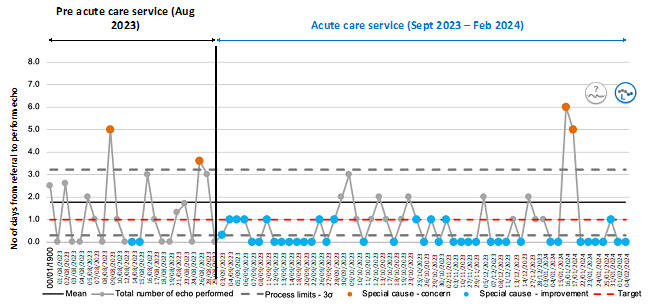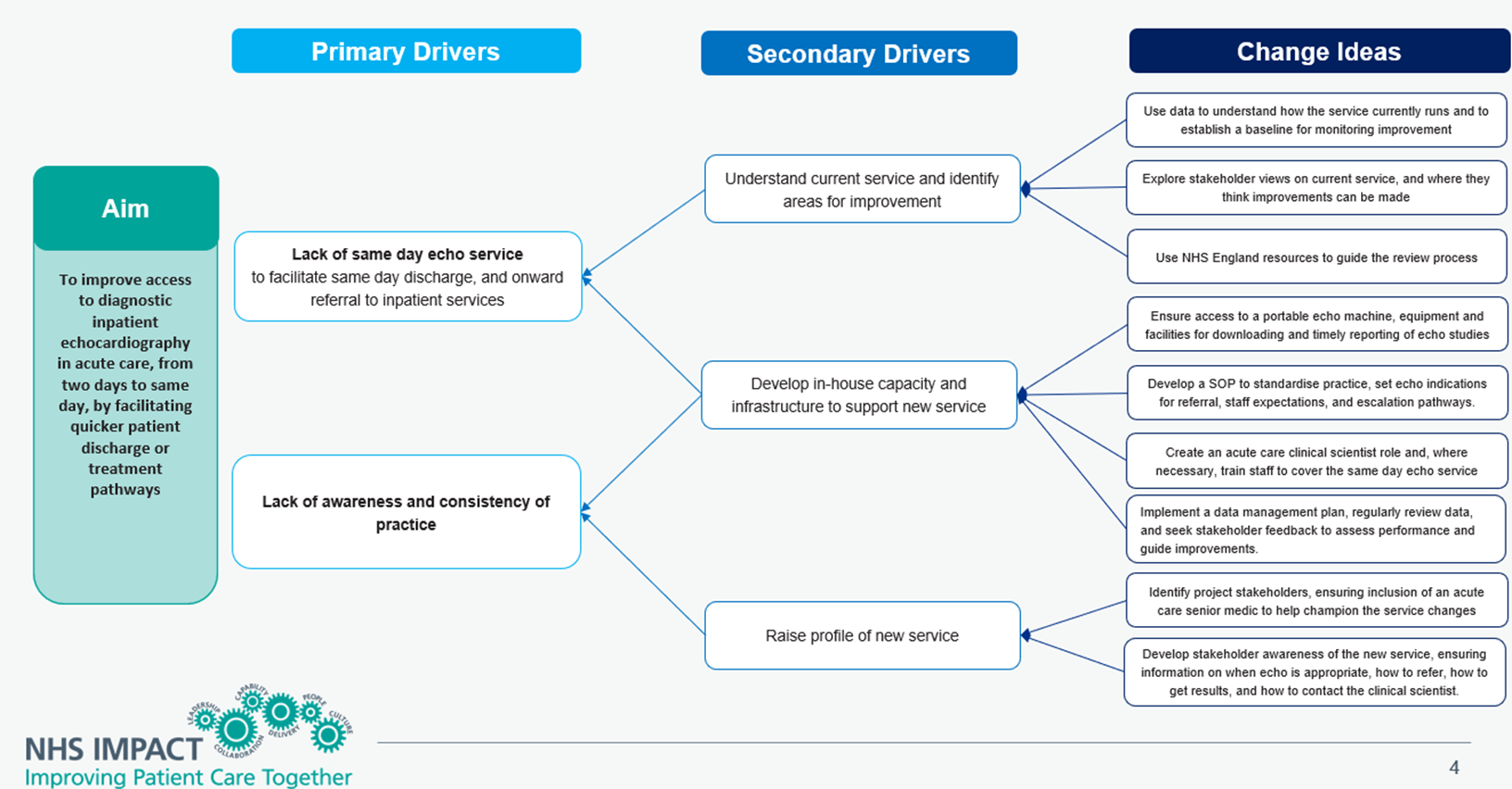Background
Local audit data identified that inpatients wait up to 2 days for diagnostic echocardiography (echo) at Guy’s and St Thomas’ NHS Foundation Trust (GSTT). This did not meet the clinical needs of a busy acute care department, including A&E, same day emergency care, and an acute admissions ward. Without access to a same day echo service, GSTT saw delayed patient discharges and increased outpatient echo waiting lists due to patients being discharged before their scan.
The echo team engaged in a quality improvement project to pilot a same day echo service for patients in acute care, aiming to facilitate quicker patient discharge or treatment pathways. This guide shares their learning, allowing others to adopt a similar approach to address the high demand for inpatient echo in busy acute care departments.
Benefits observed
- the percentage of acute care inpatients receiving an echo within 24 hours doubled from 46% before the pilot, to 92% when the new service was running
- same day echo facilitated a same day discharge for 40% of acute care inpatients, and an onward referral to cardiology inpatient services for 17% of patients
- improved relationships between acute care medical staff and the echo department were observed in terms of communication, appropriateness of the echo request, echo result interpretation and onward referral to cardiology services if indicated
- training opportunities have arisen for acute care medical staff to gain British Society of Echocardiography (BSE) L1 accreditation, facilitated by having a regular member of the echo team present on acute care wards to provide echo training
The steps to improve access to echo
1. Stakeholder mapping
- identify stakeholders who will be affected by your quality improvement project. This will likely include patients, acute care medical staff, echo clinical scientists, cardiac physiologists, directorate management teams, IT services and medical physics ultrasound equipment engineers
- involve an acute care senior medic who can act as a point of contact within the acute care department and help champion the implementation of the new service into the acute care workflows
2. Review the current service
- use data to understand how your service currently runs and establish a baseline to measure improvement. Some measures you may wish to include:
- number of inpatient echo referrals made from acute care
- time from echo referral to scan
- number of patients discharged with an outpatient echo referral
- engage stakeholders to discover their views on the current inpatient echo service and where they think improvements can be made
- Utilise NHS England resources such as First steps towards quality improvement: a simple guide to improving services. NHS Improving quality
3. Establish logistics and infrastructure
- echo machine – is there a portable echo machine that could be used in acute care? Do you need to submit a business case to purchase an additional machine?
- connectivity – do you need to be able to download echo studies in the acute care department? do you have the correct equipment to facilitate this (ie ethernet cables, active download ports, sufficient Wi-Fi)?
- reporting – do you have the necessary facilities to report echo studies in acute care in a timely manner?
4. Develop a standard operating procedure
- a standard operating procedure should outline the day-to-day running of the same day echo service to standardise practice across all staff groups involved
- the standard operating procedure should include the appropriate echo indications for referral to the service, the expectations expected of staff working within the service, as well as the appropriate escalation pathways for abnormal echo findings
5. Create a role for an acute care clinical scientist
- within working hours, rota a clinical scientist within the echo team to cover the same day echo service. Ensure the staff member is inducted into the acute care department and is familiar with the standard operating procedure
- the clinical scientist filling this role should:
- have clinical skills training
- be able to interpret blood test results, chest x-rays, and other diagnostic imaging to help triage referrals
- communicate effectively with the acute care medical teams
6. Raise the profile of the new service
- inform stakeholders of the new service and the role of the acute care clinical scientist
- ensure the acute care department is aware of the appropriate referral pathways into the service, when echo is appropriate, how to get echo results, and how to contact the acute care clinical scientist (eg bleep, phone extension)
7. Continue to monitor service performance
- formulate a data management plan to measure whether your changes are leading to improvements. Use daily or weekly statistical process control charts to visually demonstrate and monitor service performance. Data should be reviewed regularly and used to direct your changes
- meet with stakeholders to gauge their opinions on the service and harvest ideas for further improvement
Figure 1: the average number of days from referral to echo, comparing before and after the introduction of the acute care service

Figure 1 above shows that the percentage of patients receiving an echo within 24 hours has increased from 46% before the start of the service, to 92% when the service is running.
Overcoming challenges at Guy’s and St Thomas’ NHS Foundation Trust
Challenge: lack of echo workforce
Clinical scientists and cardiac physiologists are currently facing a national workforce shortage. On days with high staff sickness or annual leave it was not always possible to remove a member of staff from the general echo rota to provide cover for the acute care echo service.
Solution: recruit an acute care clinical scientist
Submit a business case or apply for external funding for a full-time acute care clinical scientist position. Use the data collected to support your application for funding, demonstrating the value of the service on patient care. In addition, new services such as this may offer improved job satisfaction and help retain clinical scientists and cardiac physiologists in their NHS roles.
Challenge: working hours of echo service
Acute care requires access to echocardiography 24 hours a day, 7 days a week. Currently the acute care echo service is only able to cover normal working hours, Monday to Friday.
Solution: train acute care medical staff to cover the service
Training acute care medical staff in echo whilst working towards BSE L1 accreditation may offer out of hours cover for the service in the future. This approach has been successfully adopted at GSTT, with 5 acute care medics currently working towards BSE L1 accreditation.
Challenge: obtaining stakeholder engagement
Stakeholder engagement and support is key for service development. It can be difficult to have access to these individuals in departments outside of the cardiology speciality, particularly in a busy acute care department. Furthermore, non-medical stakeholders may not understand the value of an echo service based in acute care.
Solution: involve an acute care senior medic who can act as a champion for the service
An acute care senior medic can engage the appropriate stakeholders from the acute care department.
Data collected from audit can also play a role, demonstrating to stakeholders the weakness of the current inpatient echo system and the strengths and cost savings of an acute care echo service.
Challenge: raising the profile of the new service
This can be a challenge in a busy acute care department.
Solution: use a senior medic in acute care to champion the service amongst colleagues
Posters explaining the purpose of the service, referral criteria and contact information can be useful visual aids to prompt medics to refer to the service.
Additionally, ensuring that the clinical scientist is based on the acute care wards will enable them to integrate within the acute medical teams. This provides the acute care medics with the opportunity to ask questions regarding appropriate referral to the service, echo report interpretation, and timely referral to inpatient cardiology services.
Figure 2: driver diagram: access to diagnostic inpatient echocardiography in acute care

Figure 2: access to diagnostic inpatient echocardiography in acute care driver diagram – click to view accessible text version of this diagram.
Reading from left to right
Aim:
To improve access to diagnostic inpatient echocardiography in acute care, from 2 days to same day, by facilitating quicker patient discharge or treatment pathways.
Primary drivers:
- lack of same day echo service to facilitate same day discharge, and onward referral to inpatient services
- lack of awareness and consistency of practice
Secondary drivers:
- understand current service and identify areas for improvement
- develop in-house capacity and infrastructure to support new service
- raise profile of new service
Change ideas
- use data to understand how the service currently runs and to establish a baseline for monitoring improvement
- explore stakeholder views on current service, and where they think improvements can be made
- use NHS England resources to guide the review process
- ensure access to a portable echo machine, equipment and facilities for downloading and timely reporting of echo studies
- develop a standard operating procedure to standardise practice, set echo indications for referral, staff expectations, and escalation pathways
- create an acute care clinical scientist role and, where necessary, train staff to cover the same day echo service
- implement a data management plan, regularly review data, and seek stakeholder feedback to assess performance and guide improvements
- identify project stakeholders, ensuring inclusion of an acute care senior medic to help champion the service changes
- develop stakeholder awareness of the new service, ensuring information on when echo is appropriate, how to refer, how to get results, and how to contact the clinical scientist
Links and resources
- How to implement a quality improvement project: First steps towards quality improvement: A simple guide to improving services.
- To speak to someone at Guys & St Thomas’ NHS Foundation Trust about this project, please contact jenna.smith@gstt.nhs.uk or camelia.demetrescu@gstt.nhs.uk.
- Further resources on diagnostics can be found on the National Diagnostics Transformation FutureNHS page. An NHS email address will be required to access the page.
Publication reference: PRN01007

